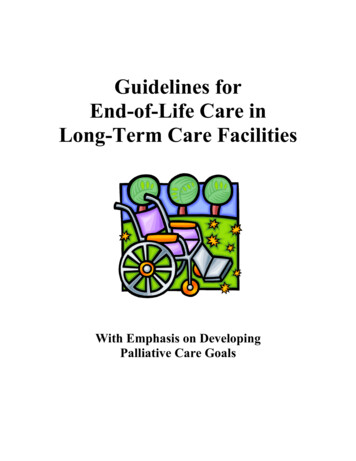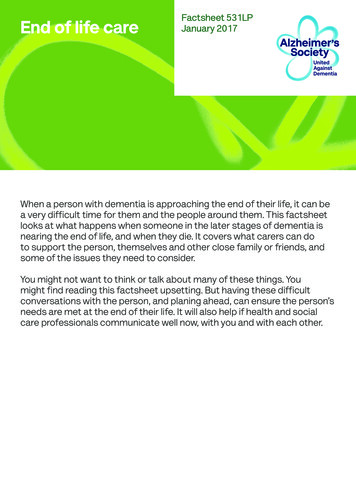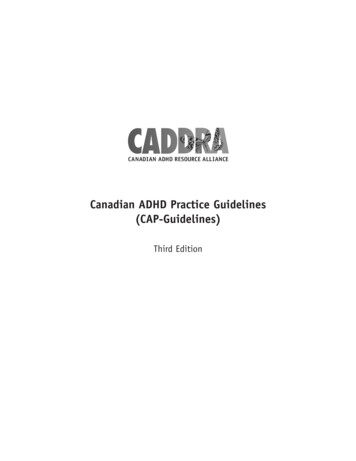
Transcription
Guidelines forEnd-of-Life Care inLong-Term Care FacilitiesWith Emphasis on DevelopingPalliative Care Goals
Guidelines forEnd-of-Life Care inLong-Term Care FacilitiesWith Emphasis on DevelopingPalliative Care Goals
Guidelines for End-of-Life CareIn Long-Term Care FacilitiesEmphasis on Developing Palliative Care GoalsDeveloped byMissouri End of Life Coalition’sEnd of Life in the Nursing Home Task ForceMissouri Department ofHealth and Senior ServicesDivision of Senior Services and RegulationSeptember 2003Missouri Department of Health and Senior ServicesDivision of Senior Services and RegulationMissouri End of Life Coalition’s End of Life in the Nursing Home Task ForcePost Office Box 570, Jefferson City, MO 65102-0570
About UsThe Missouri Department of Health and Senior Services enhances quality of life for allMissourians by protecting and promoting the community’s health and well being ofcitizens of all ages.Richard Dunn, DirectorMissouri Department of Health and Senior ServicesDavid Durbin, M.P.A., DirectorDivision of Senior Services and RegulationAN EQUAL OPPORTUNITY/AFFIRMATIVE ACTION EMPLOYERServices provided on a nondiscriminatory basisThe Missouri End of Life CoalitionMission StatementThe Missouri End-of-Life Coalition is committed to fostering cooperation, education, andresearch to promote high quality care for the dying.Chairman - Steven Zweig, MD, MSPH, Professor, School of Medicine, University of MissouriColumbiaVice Chairman/Chairman Elect - Jim Duff, Diagnostic Clinic, SpringfieldSecretary - Debbie Oliver, PhD, Associate Professor, University of Missouri-Columbia Schoolof Social WorkTreasurer - Jane Armer, PhD, RN, Director, Nursing Research, Ellis Fischel Cancer Center andAssociate Professor, University of Missouri-Columbia Sinclair School of NursingExecutive Secretary - Cindy Baird, Missouri Hospice and Palliative Care AssociationPast Chair - Clay Anderson, MD, Assistant Professor, University of Missouri School ofMedicineDisclaimerThe guidelines in this manual are not a guarantee of compliance with the regulations forMedicare/Medicaid certified facilities and Missouri licensure. Before implementing theseguidelines, each facility must develop written policies and procedures, specific to eachfacility, and instruct their staff regarding the appropriate use of these tools. We alsorecommend that the facility’s legal counsel review its policies and procedures prior toimplementing them.
AcknowledgmentsThe Missouri Coalition’s End of Life Task Force gratefully acknowledges the NursingFacility Quality of Care Fund and Incarnate Word Foundation whose generous giftenables us to provide a copy of this manual to each intermediate care and skilled nursingfacility in Missouri.Emphasis on Developing Palliative Care GoalsRecognizing a continuing need to discuss critical issues related to developing andrevising plans of care for patients residing in nursing facilities at the end of life, theMissouri End of Life Coalition established an End of Life in the Nursing Home TaskForce to provide guidance on appropriate palliative care objectives for residents in longterm care facilities.The task force and the Missouri Department of Health and Senior Services, Division ofSenior Services and Regulation have produced this consensus document. Between 2001and 2003, the group met with key healthcare agencies and organizations throughoutMissouri to ensure that expertise in long-term care, pain and symptom management,nutrition, spiritual and psychosocial care, administration, and public health were fullyrepresented.The goals of the task force were to identify barriers to proper end-of-life care;increase the clarity of the value and role of end-of-life care goals for LTC facilityresidents and their families;develop clinical tools to assist in the identification of appropriate residents forend-of-life care goals and educate care givers about these goals provide for theirimplementation and appropriate use;identify common language and culture difference and provide education todevelop clearer communication;investigate barriers to providing effective hospice services in nursing facilities byprofiling existing facilities where hospice care is provided effectively andefficiently;review the conditions of participation related to hospice in facility settings;develop a process by which LTC facilities are encouraged to utilize hospice toprovide the benefit from hospice care for dying patients and their families;provide education for hospices, long- term care facilities, hospice regulators, andlong- term care regulators on nursing facilities requirements regarding hospiceand end-of-life care for LTC facilities residents.The resulting guidelines are a source of information for facility staff.
End of Life in the Nursing Home Task ForceMarlene AndersonDirector of OperationsMissouri Health Care AssociationMary Mitchell, BS, RNVice President, Resident ServicesHealth Facilities ManagementCindy BairdExecutive DirectorMissouri Hospice & Palliative CareAssociationDebbie Oliver, MSW, PhDSchool of Social Work, University ofMissouri-ColumbiaDenise ClemondsExecutive DirectorMissouri Association of Homes for theAgingCharles Crecelius, MD, FACP, CMDMissouri Association of Long TermCare PhysiciansGinger Farley, ACSW, LMSW, LCSWHospice Preferred ChoiceJanet GardProgram DirectorCommunity Hospice of America –Tri LakesLinda Grotewiel, RNBureau AdministratorMissouri Department of Health & SeniorServices, Division of Senior Servicesand RegulationBetty Markway, RN, MSNMissouri Department of Health andSenior Services, Division of SeniorServices and RegulationDeborah Reynolds, LPAAdmissions CoordinatorBoone Retirement CenterDon Reynolds, JDMidwest Bioethics CenterYvonne Schwandt, RNPathways Community HospiceCarol J. ScottState Long-Term Care OmbudsmanMissouri Department of Health andSenior ServicesPamela C. Shipman, RN, BSNVice President of Operations for DelmarGardens EnterprisesStephen Smith, MDivLiberty Hospital
Review Committee — Department of Health and Senior Services,Division of Senior Services and Regulation:Lisa Byergo, BSPatricia Prince, RNCJanice Frank, RNBonnie Quick, RNLinda Grotewiel, RNGarry Thompson, MSWNina Hazelton, JDShelly Williamson, BS, MSBetty Markway, RN, MSNA special thank you to Rachel Reeder, Editor, Midwest Bioethics Center, for hercontributions to this publication.
Page 1 of 4Issued 09/01/2003Section: Table of ContentsGUIDELINES FOR END OF LIFE CARE INLONG-TERM CARE FACILITIESEmphasis on Developing Palliative Care oseDying in Nursing HomesDefining Palliative CarePrinciples of Palliative CareIdentifying Patients for Palliative CareReferences2.02.12.22.3Goals of CarePurpose and ObjectivesIndividualized Care — Purposeful Observation and ConversationsAdvance Care PlanningA. Defining Quality of LifeB. Residents without Decision-Making AbilityC. Shaping Care and Setting GoalsD. Ethics Case ConsultationE. Regulatory Compliance for Advance DirectivesDescribing the Goals of CareA. Ongoing Assessment and Care Plan Revision within the Palliative Care GoalB. Recognizing the Need to Revise GoalsC. The MDS and Goal-SettingD. CMS Clarification of Significant Change AssessmentRegulatory ComplianceA. State RegulationB. Federal Regulation — Achieving the Highest Practical Level of Well-BeingC. Factors That May Lead to Abuse and NeglectD. Avoidable versus Unavoidable OutcomesDocumentationCase StudyReferences2.42.52.62.72.8END OF LIFE CARE FOR PATIENTS RESIDING IN NURSING FACILITIES
Section: Table of 4.44.54.64.74.8Page 2 of 4Issued 09/01/2003Pain ManagementPurpose and ObjectivesIntroduction — Responsibility for Effective Pain ReliefCommon Misconceptions about PainConsequences of Untreated Pain — What Happens If Pain Isn’t Properly Treated?Descriptions of PainA. By Duration, Table 1.B. By Type, Table 2.Pain Assessment — Assessing Pain in Residents with Dementia orCommunication DifficultyTreatment of PainA. Rules of ThumbB. The World Health Organization Analgesic LadderC. Pain Management in the ElderlyD. Opioid Use in the ElderlyE. Pain Management Risk in LTC ResidentsF. What Everyone Can Do to Manage PainMDS and Regulatory RequirementsA. State Licensure RequirementB. Federal Certification RequirementReferencesNutrition and HydrationPurpose and ObjectivesNutrition and Hydration in Accordance with the ComprehensiveAssessment and Plan of CareA. Appropriate Nutrition and Hydration GoalsB. Inappropriate Nutrition and Hydration GoalsComfort versus DistressA. Food and Hydration as ComfortB. Food and Hydration as DistressC. Lack of Food and Hydration as ComfortD. Lack of Food and Hydration as DistressNutrition and Hydration Regulatory End-of-Life GuidelinesMedicationsParenteral and Enteral Feedings — Regulatory Compliance in the Use of FeedingTubesFamily Attitudes — Facility staff Becomes like FamilyReferencesEND OF LIFE CARE FOR PATIENTS RESIDING IN NURSING FACILITIES
Section: Table of 196.206.21Page 3 of 4Issued 09/01/2003Spiritual and Psychosocial IssuesPurpose and ObjectivesSpiritual Care — Religion and SpiritualityPsychosocial CareAssessing Psychosocial and Spiritual SufferingPsychosocial and Spiritual Care InterventionsRegulatory RequirementsA. MDS SectionsB. The Right to Participate in Groups, State Licensure RequirementC. The Right to Participate in Groups, Federal RequirementD. Social Service, Federal RequirementReferencesHospice CollaborationPurpose and ObjectivesDefinition of Hospice CareHospice ServicesDetermination of Hospice Eligibility — General CriteriaCore ServicesResponsibilities of ProvidersResponsibilities Related to the Eligibility/Admission Process of LTC ResidentsElecting Hospice ServicesIntegrated Plan of CarePhysicians OrdersMedical Records ManagementUtilization of Therapy ServicesLoss and Grief ServicesResponsibilities at Time of DeathHospitalization and Emergency CareRevocation/Decertification/TransferRespite and Acute Patient Care in the Nursing HomeHospice ReimbursementLong-Term Care Regulatory Requirements and Expectations for Hospice ServicesA. Regulatory Requirements and ExpectationsB. Major Concern Areas1. CMS Identification of Problem Areas2. SLCR Identification of Major Concern AreasCase StudySample Integrated Plan of Care after Hospice AdmissionReferencesEND OF LIFE CARE FOR PATIENTS RESIDING IN NURSING FACILITIES
Section: Table of ContentsPage 4 of 4Issued 09/01/2003AppendicesA. Manual AcronymsB. GlossaryC. Care Plans Interventions1. Gastrointestinal Symptom Management/Care Plan Interventions for the NurseAide and Interdisciplinary Team2. General Symptom Management/Care Planning Interventions for Nurse Aideand Interdisciplinary Team3. Imminent Death/Care Plan Interventions4. Imminent Death/Care Plan Interventions for the Nurse Aide5. Pain Management/Care Plan Interventions for the Nurse AideD. Pain Assessment Tools1. Questions about Pain to be included in Routine Nursing AdmissionAssessment2. Initial Pain Assessment Tool3. Pain Assessment Form4. Pain Assessment — Pain Rating ScalesE. Psychosocial/Spiritual Assessment Tools1. My Bill of Rights2. Religious Practices for End-of-Life CareF. Local Medical Review Policies – Hospice – Determining Terminal Status DiseaseSpecific GuidelinesG. Considerations Regarding Life-Prolonging Treatment for Residents of LongTerm Care FacilitiesEND OF LIFE CARE FOR PATIENTS RESIDING IN NURSING FACILITIES
Page 1 of 1Issued 09/01/2003Section 1.0 IntroductionSubsection: Table of troductionPurposeDying in Nursing HomesDefining Palliative CarePrinciples of Palliative CareIdentifying Residents for Palliative CareReferencesEND OF LIFE CARE FOR RESIDENTS IN NURSING FACILITIES
END OF LIFE CARE FOR RESIDENTS IN NURSING FACILITIES
Page 1 of 1Issued 09/01/2003Section 1.0 IntroductionSubsection 1.1 PurposeINTRODUCTIONPurposeThe Missouri End-of-Life Coalition was formed in the spring of 1998. The Coalitionis comprised of professionals, practitioners, policymakers, regulators, affiliatedprofessional associations and end-of-life care providers. The mission of the Coalitionis to foster cooperation, education and research to promote high quality care for thedying. The Coalition identified access to adequate end-of-life care (including hospicecare) in nursing homes as a problem, and formed a task force of nursing home andhospice associations, providers, and state survey agencies to deal with this problem.The initial goal was to identify state regulatory and reimbursement concerns and otherbarriers that impede utilization and access. In its initial attempt to explore the problemin 1999, the task force gathered two focus groups of providers to discuss the issue.The focus groups perceived regulatory issues as barriers; however, they did not findany regulations preventing the adequate provision of appropriate end-of-life care inMissouri nursing homes. The access barriers they did find include the existence ofmyths and a lack of education and coordination among nursing homes, nursing homesurveyors, and hospice agencies.Many regulatory concerns have been expressed about the care provided for residentsdying in long-term care (hereafter, LTC). The committee felt it was important forstate survey agencies to give direction to LTC facilities and hospice providers tocorrect or diminish misinformation. This manual is designed to help LTC staffunderstand their role and responsibility to provide palliative care. Palliative care is animportant and necessary goal for nursing home residents, 30 percent of whom will diefrom chronic or acute illness within the first year of their admission into a nursingfacility. The goal of this manual is to show LTC staff when and how to setappropriate palliative care goals. It will also serve as a reference tool and guide toadditional resources.END OF LIFE CARE FOR RESIDENTS IN NURSING FACILITIES
END OF LIFE CARE FOR RESIDENTS IN NURSING FACILITIES
Section 1.0 IntroductionSubsection 1.2 Dying in Nursing HomesPage 1 of 2Issued 09/01/2003Dying in Nursing HomesDeath in America is changing. Many years ago death occurred in homes; then itmoved into hospitals, and recent trends indicate that death is moving into nursinghome settings. Currently, 28 percent of deaths in Missouri occur in nursing homes,compared to a national average of 24 percent (Abbasi and Rudman, 1994). Somesources estimate that by 2020, 40 percent of deaths in this country will occur innursing homes (Christopher, 2000).Death is already a frequent occurrence in the long-term care setting as approximatelyone-third of nursing home residents die within one year of admission. Research hasshown that the quality of end-of-life care throughout the healthcare system is in needof improvement. Nursing homes, like all other healthcare institutions, face majorchallenges in meeting family expectations at the end of life (Hanson, Danis, andGarrett, 1997). Pain and symptom control, and spiritual and emotional supports arenecessary and require a specialized focus at the end of life (Keay, 1999).Recently, much attention has been given to the discrepancy between the wayindividuals desire to die and the way they are dying. Dying in our country is notalways a peaceful process. In a national survey in 1999, half of the respondents saidthe healthcare system does not always keep dying patients pain-free (Fackelmann,1999). In 1997, the American Health Decisions Project conducted thirty-six focusgroups throughout the country and found that people fear reaching the end of theirlives dependent on machines. Participants expressed a preference for a natural deathin familiar surroundings and in the presence of loved ones. Participants said they didnot believe the current healthcare system is consistent with their views on death anddying, and that current planning options do not support patient management of thedeath and dying experience (Stanley, 1997).Further research tends to substantiate the public’s fears. The Study to UnderstandPrognoses and Preferences for Outcomes and Risks of Treatments (SUPPORT),published in 1995, discovered that 38 percent of seriously ill patients who died duringthe study spent at least ten days in an intensive care unit of a hospital. It also foundthat of patients who were conscious when they died (about 50 percent of the studygroup who died in the hospital), family members reported moderate to severe pain inthese patients at least half the time. Data show that Missouri is no different. A recentstudy by Brown Medical School (2001) found that 47 percent of terminally illpatients in Missouri nursing homes experience persistent pain.Numerous studies have tried to determine the causes of our inability to provide bettercare for the dying. Barriers to proper care for the dying include inadequatereimbursement, cultural attitudes on death and dying, discomfort with communicatingEND OF LIFE CARE FOR RESIDENTS IN NURSING FACILITIES
Section 1.0 IntroductionSubsection 1.2 Dying in Nursing HomesPage 2 of 2Issued 09/01/2003bad news and prognoses, and healthcare providers’ lack of education on caring for thedying. In a survey conducted by the American Medical Association (AMA) in 19971998, only four medical schools required coursework on care for the dying. Inresponse to its survey, the AMA developed a curriculum to help practicing physiciansimprove their end-of-life practice (Emmanuel, VonGuten, Ferris, and Portnoy, 1999).As a result of the attention being brought to these limitations in the healthcaresystem’s focus on dying in America, a new specialization is gaining attention andsupport. This medical specialization involves the practice of palliative medicine.END OF LIFE CARE FOR RESIDENTS IN NURSING FACILITIES
Section 1.0 IntroductionSubsection 1.3 Define Palliative CarePage 1 of 1Issued 09/01/2003Defining Palliative CareMany groups have defined palliative medicine. Each definition has a common focuson relieving suffering and improving quality of life. Palliative medicine hastraditionally been tied to the provision of hospice care; however, there are numerousobstacles to the use of hospice care. Therefore, the “palliative care movement” hasbroadened beyond hospice and now recognizes that hospice care is only one model ofpalliative medicine. It is not necessary for a resident to be in a hospice program toreceive palliative care. Residents can benefit significantly from a palliative approachin which attention to the patient’s physical, spiritual, and psychosocial problemsbecomes the guiding philosophy.Regardless of the exact program or model, the World Health Organization (WHO)defines palliative care asthe active total care of patients whose disease is not responsive to curativetreatment. Control of pain, of other symptoms, and of psychological, socialand spiritual problems, is paramount. The goal of palliative care isachievement of the best quality of life for patients and their families. Manyaspects of palliative care are also applicable earlier in the course of the illnessin conjunction with anti-cancer treatment (1990).WHO expanded the definition to include six additional points regarding palliativecare. Palliative care: affirms life and regards dying as a normal process;neither hastens nor postpones death;provides relief from pain and other distressing symptoms;integrates the psychological and spiritual aspects of care, fosteringopportunities to grow;offers an interdisciplinary team to help residents live as actively as possibleuntil death; andoffers support systems for the family during the resident’s illness and theirown bereavement (1990).END OF LIFE CARE FOR RESIDENTS IN NURSING FACILITIES
END OF LIFE CARE FOR RESIDENTS IN NURSING FACILITIES
Section 1.0 IntroductionSubsection 1.4 Principles of Palliative CarePage 1 of 1Issued 09/01/2003Principles of Palliative Care“Principles for Care of Patients at the End of Life,” authored by renowned palliativephysicians Christine Cassell and Kathleen Foley, is a declaration of basic principlesfor all healthcare professionals. It has been endorsed by a growing number ofphysician organizations. The American Medical Association, American Associationof Hospice and Palliative Medicine, American Geriatric Society, American College ofPhysicians, American Association of Family Practice, American Medical DirectorsAssociation, American College of Surgeons, American Academy of Pediatricians,and the American Pain Society, among others, have accepted these principles.These principles are quite applicable to the LTC facility and should guide efforts atproviding humane, palliative care: Respect the dignity of both patient [resident] and care givers.Be sensitive and respectful of the patient’s [resident’s] and family’s wishes.Use the most appropriate measures that are consistent with patient [resident]choices.Encompass alleviation of pain and other physical symptoms.Assess and manage psychological, social and spiritual/religious problems.Offer continuity (the patient should be able to continue to be cared for if sodesired by his primary care and specialist providers).Provide access to any therapy that may be expected to improve the patient’s[resident’s] quality of life including alternative or nontraditional treatments.Provide access to palliative care and hospice care.Respect the right to refuse treatment.Respect the physician’s professional responsibility to discontinue sometreatments when appropriate with consideration of both patient [resident] andfamily preferences.1Promote clinical and evidence-based research on providing care at the end oflife.1While these principles may provide overall guidance for end-of-life care, the work group urges long-termcare facilities to consult with their legal counsel with regard to surrogate decision-making issues.END OF LIFE CARE FOR RESIDENTS IN NURSING FACILITIES
END OF LIFE CARE FOR RESIDENTS IN NURSING FACILITIES
Section 1.0 IntroductionSubsection 1.5 Identifying Residents for Palliative CarePage 1 of 1Issued 09/01/2003Identifying Residents for Palliative CareDeciding if a resident is appropriate for palliative care is not an easy task. Physicians,residents, families and staff are challenged to determine when a resident is coming to theend of his or her life. Since most people are somewhat familiar with the hospice model ofpalliative care, we will use hospice criteria to help LTC staff identify residents eligiblefor palliative care. The following general criteria are used by hospice agencies todetermine eligibility. The eligible patient: has been diagnosed with a terminal or life ending illness;has a life expectancy of six months or less, as determined by the attendingphysician and the hospice interdisciplinary team;is seeking palliative care (pain and symptom relief) rather than curative treatment.understands, as do the family and his or her physicians that artificial, lifeprolonging procedures are not consistent with hospice care; andhas been approved for admission to hospice services by the attending physicianand the hospice medical director.The most difficult part of determining a patient's eligibility for hospice benefits is thephysician's certification that the patient has a prognosis of six months or less. To helpphysicians and hospices identify patients who may be hospice appropriate, the Centersfor Medicare and Medicaid Services (CMS) have issued a Local Medical Review Policy(LMRP) that defines (by disease) prognostic criteria that should be examined todetermine the patient’s eligibility.These guidelines examine documentable evidence that “if the disease follows its normalcourse: the prognosis would be six months or less.” Currently, twelve guidelines havebeen identified including lung disease, heart disease, kidney failure, HIV, stroke andcoma, dementia, liver failure, ALS, lung cancer, prostate cancer, breast cancer anddecline in health status. The LMRPs for Dementia and Decline in Health Status areincluded in the appendix section of this manual. Other LMRP guidelines can be viewedon the web at www.iamedicare.com/provider/policies.END OF LIFE CARE FOR RESIDENTS IN NURSING FACILITIES
END OF LIFE CARE FOR RESIDENTS IN NURSING FACILITIES
Page 1 of 1Issued 09/01/2003Section 1.0 IntroductionSubsection 1.6 ReferencesReferencesAbbasi, A. A, and D. Rudman. 1994. “Undernutrition in the nursing home: Prevalence,consequences, causes, and prevention.” Nutrition Review 52(1):113-122Billings, J. Andrew. 1985. “Comfort Measures for the Terminally Ill, Is DehydrationPainful?” Journal of the American Geriatric Society 33(11): 808-810.Brown Medical School, The Center for Gerontology and Healthcare Research andDepartment of Community Medicine, htmCancer Pain Relief and Palliative Care. 1999. Technical Report Series 804. Geneva,Switzerland: World Health Organization.Christopher, Myra. 2000. Benchmarks to Improve End-of-Life Care. Kansas City, MO:Midwest Bioethics Center.Emmanuel, Linda., Charles F. von Guten, Frank D. Ferris, and Russell Portney, editors.1999. The EPEC Curriculum: Education for Physicians on End-of-Life Care: TheEPEC Project. Chicago: American Medical Association.Fackelmann, Kathleen. 1999, March 18. “Survey Supports Pain-Free Living for DyingPatients.” USA Today, p. 9D.Hanson, Laura C., Marion Danis, and Joanne Garrett. 1997. “What Is Wrong with Endof-Life Care? Opinions of Bereaved Family Members. Journal of the AmericanGeriatric Society 45(6): 1339-1344.Keay, Timothy J. 1999. Palliative Care in the Nursing Home. Generations 23(1): 96-98.Sources of Payment for Nursing Home Residents, 1996. (AHRQ No 01-0010). Rockville,MD: Agency for Healthcare Research and Policy.Stanley, John M. 1997. “The Quest to Die with Dignity: An Analysis of Americans’Values, Opinions and Attitudes concerning End-of-Life Care.”Appleton, WI:American Health Decisions.END OF LIFE CARE FOR RESIDENTS IN NURSING FACILITIES
END OF LIFE CARE FOR RESIDENTS IN NURSING FACILITIES
Page 1 of 1Issued 09/01/2003Section 2.0 Goals of CareSubsection: Table of ContentsGOALS OF CAREContents2.02.12.22.32.42.52.62.72.8Goals of CarePurpose and ObjectivesIndividualized Care — Purposeful Observation and ConversationsAdvance Care PlanningA. Defining Quality of LifeB. Residents without Decision-Making AbilityC. Shaping Care and Setting GoalsD. Ethics Case ConsultationE. Regulatory Compliance for Advance DirectivesDescribing the Goals of CareA. Ongoing Assessment and Care Plan Revision within the Palliative Care GoalB. Recognizing the Need to Revise GoalsC. The MDS and Goal SettingD. CMS Clarification of Significant Change AssessmentRegulatory ComplianceA. State RegulationB. Federal Regulations — Achieving the Highest Practical Level of Well-BeingC. Factors That May Lead to Abuse and NeglectD. Avoidable versus Unavoidable OutcomesDocumentationCase StudyReferencesEND OF LIFE CARE FOR RESIDENTS IN NURSING FACILITIES
END OF LIFE CARE FOR RESIDENTS IN NURSING FACILITIES
Section 2.0 Goals of CareSubsection 2.1 Purpose/Objectives/OutlinePage 1 of 1Issued 09/01/2003GOALS OF CAREPurpose and ObjectivesThis chapter identifies four types of resident goals in long-term care: rehabilitation,prevention, maintenance and palliation. Goals for care need to reflect the resident’schange of condition. These goals result from purposeful conversations with theresident/responsible party, family, facility staff, and physician.Objectives Understand the diversity of residents in long-term care facilities, and thus theneed for individualized plans of care. Appreciate the need for, and know how to develop and change the plan of carebased on the resident’s or responsible party’s wishes. Apply regulatory guidance for end-of-life care in long-term care.END OF LIFE CARE FOR RESIDENTS IN NURSING FACILITIES
END OF LIFE CARE FOR RESIDENTS IN NURSING FACILITIES
Section 2.0 Goals of CareSubsection 2.2 Individualized CarePage 1 of 2Issued 09/01/2003Individualized Care — Purposeful Observation and ConversationsLong-Term Care facilities care for a wide variety of residents. Caregivers may have adifficult time meeting all the needs of this diverse population. A LTC facility may haveresidents with any combination of the following characteristics: physical impairmentcognitive impairmentbehavioral symptomsmental illnessmental retardationyoung residentsvery old residentscultural diversitylifestyle diversityresidents in the last stages of lifeAs a result of diverse needs in this population, it is important that the care plan be basedon the individual resident’s strengths, needs and problems. These individualized careplans are developed using interdisciplinary experts including the resident, physician,family, social worker, activities director, dietitian, charge nurses involved in the resident'scare, and nurse aides directly responsible for the resident’s care. This individualized careplanning process forms the basis of the Resident Assessment Instrument (RAI) which isrequired in every Medicare/Medicaid certified facility. An RAI coordinator should alsobe a member of the planning team. Individual care planning is the standard of practice forany care delivery system.Residents living in the end stages of life have great needs, and their care plans should berevised frequently. The “art and science” of nursing is portrayed at its best in palliativecaregiving.Purposeful Observation and ConversationsIndividualized care requires that facility services “fit the resident,” rather than expect theresident’s goals and needs to “fit the facility.” This approach celebrates the uniqueness ofeach resident. Generic care does not consider the uniqueness of each resident, but treatsall residents alike. If a facility develops
Missouri End of Life Coalition established an End of Life in the Nursing Home Task Force to provide guidance on appropriate palliative care objectives for residents in long-term care facilities. The task force and the Missouri Department of Health and Senior Services, Division of Senior Servi











